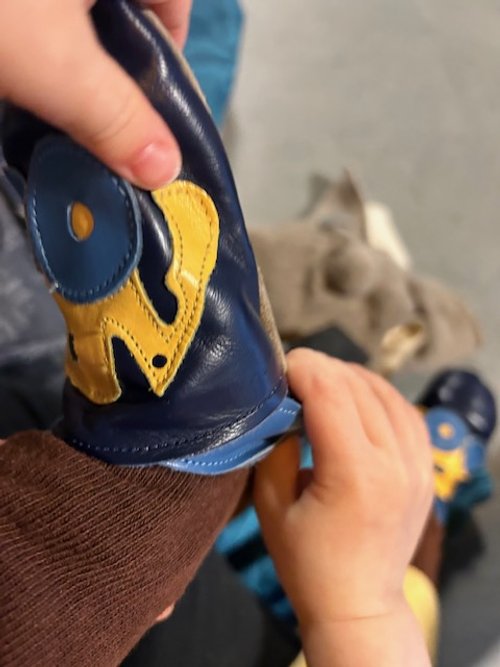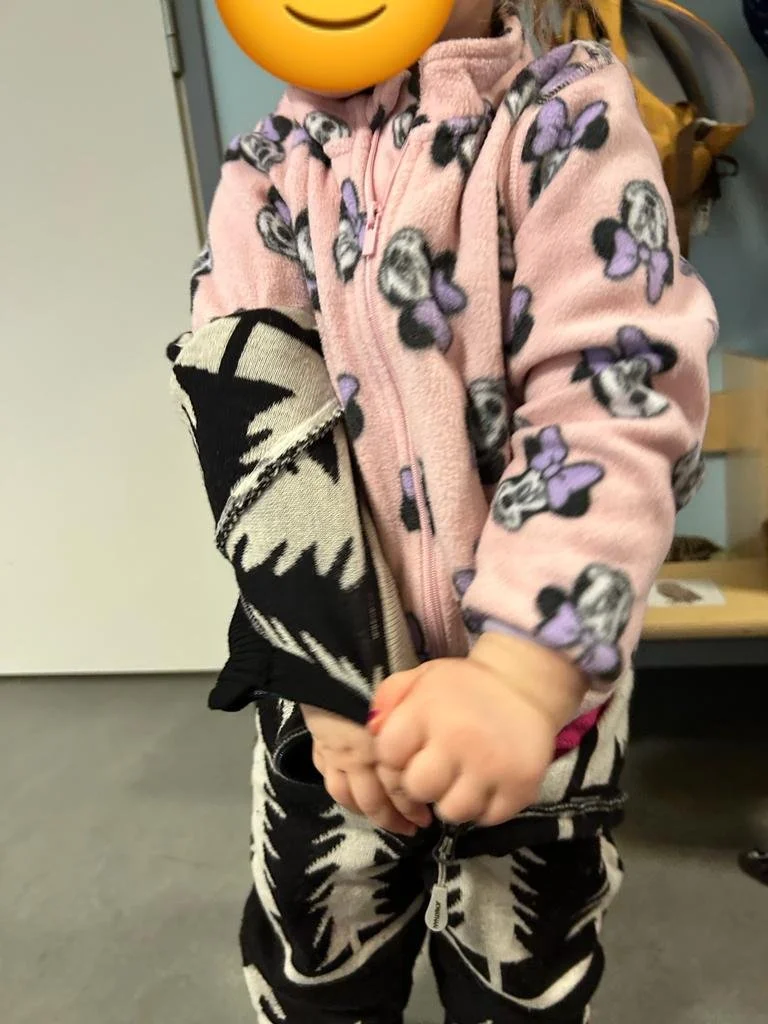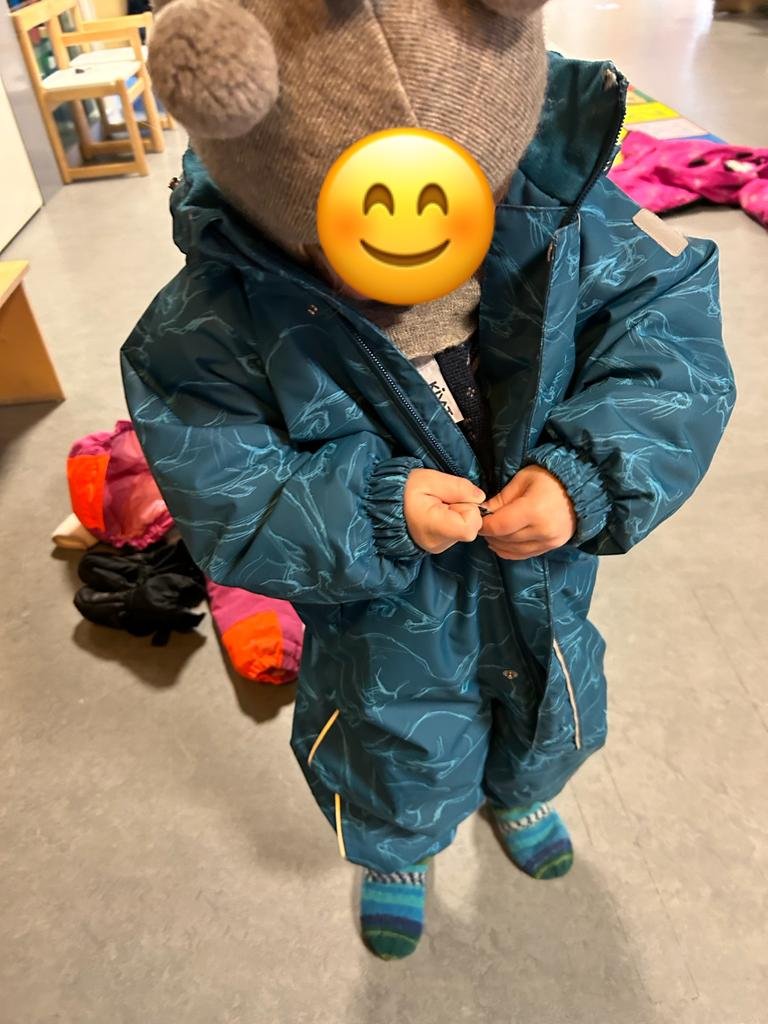Teaching Toddlers How to Dress Themselves
One of the most common things that we hear as teachers, when parents talk about their child’s dressing at home is, “they don’t do anything!”. This can be very frustrating for some parents, while other simply shrug their shoulders and say, “Well, they are still so little.” On the contrary, even at 1.5yr, they can do a lot! Here are some tips about how to get you toddler to start to dress themselves independently.
In the Kävyt group made up of 1.5-2-year-old children, we help them step by step, slowly learning how to do the simple things and work up from there. The first step that we teach is learning how to put on their slippers. Most slippers are made of soft material, easily flexible, and simple to put on. Yet even this simple task can feel extremely frustrating for toddlers. We start by sitting the child in our lap, taking their hands, and showing them how they should use both of their thumbs to open the slipper up. Since their arms aren’t long enough yet to reach their feet, we help them to bend their knee to get their toes closer to their hands. Then we encourage them to guide their toes into the slipper. Once the toes are in, we show how to pull the slipper to the back of the foot using their thumbs, and then the most difficult part, using their index finger to guide the slipper over the back of their heal. This will be practiced with them over and over again until they are able to sit on the floor and do it by themselves. Every step of the way, every little victory is highly praised to motivate them to want to do more on their own.
In showing them how to put on their slippers, it will also help them when putting on socks as well as shoes. The next step is teaching them to undress themselves. This is easier, because the clothes become looser and are easier for them to pull off. Plus, children of this age seem to enjoy opening and taking clothing off rather than trying to put them on! First, we teach them to take off their gloves and hats. Nothing else can be done until their hands are free, and they get easily frustrated when becoming too hot. Next, we show them how to grab the tab of their zipper and pull it down, opening their jacket or outside suit (in Finland, most of the outside clothes children wear are a full body suit that they can simply step into, sliding in their arms and then close the zipper. Fast and easy!) This, as well, can be challenging, using their fine motor skills to grab the small tab on the zipper and hold the top of the jacket while pulling downwards to open it up. We always encourage the children to ask for help if they are having trouble. We want them to be as independent as possible, but also ask for help when needed.
This kind of teaching is slow going and will not happen in a week. It takes time and patience. When they have done these simple steps, the teachers then help them out of the rest of their clothes. You want to increase the steps they need to take one by one, not all at once. It will be too overwhelming for them. You want to make every little step a small victory.
Next, we teach them how to grab the end of their sleeve to pull their arm out, and then next grab the cuff of their pantleg to pull their foot out. This takes time and may be very frustrating for the child. Be patient with them and guide them as needed. Praise them for trying and getting as far as they did. Once they are able to undress themselves more easily, you can start to teach them the reverse- learning to pull the clothing on.
Place their outside pants/outside suit on the floor, slid their feet into the pant legs and guide their hands onto either side of one leg to pull the fabric up, until their toes pop out. If they are lacking in motivation, you can reach into the pantleg to find their foot and begin to tickle their foot, asking, “where are your toes?!”, once they pull the fabric up so their foot has come out on the other end, exclaim, “there they are!!” You turn dressing into a game and make it fun. That is the most important part, keep it light and fun. Next thing to practice is how to find the holes for their arms and how to use their opposite hand to help pull up the material of their jacket over their shoulder. After that, show them how to find the tab to the zipper and pull up to close it (for a full body outside suit). If they have a jacket where the zipper needs to be aligned first, this is something they will not be able to do until they are closer to 3 or 4 years old. That will take time, but it doesn’t hurt to show them how it needs to be done so they can try to practice. They can also practice putting on their hat, neck-warmer, and light gloves. Heavy winter gloves are more difficult to put on, even for adults, and they will need help to place these on, as well as pulling their pant legs down over their boots.
Of course, these kinds of clothes are for the Autumn/Wintertime when it is cold, and they need heavier clothes on. We all look forward to the Spring and Summer when there aren’t that many clothes to put on to enjoy being outside. Lighter clothes are also a lot easier for toddlers to put on themselves. Encourage them every step of the way!
Everything should be done in slow stages; some might take a little longer than others. Really encourage them to try first themselves before you start to help. It's understandable if you are late for work and need to rush out the door but, if possible, try to allow enough time for them to attempt to dress themselves. It can start with even simply putting on their own socks and pants in the morning when getting dressed. If they are whining that they want to do it themselves, let them! It’s a really positive sign when children want to try new things themselves. We all know that it will go faster if an adult helps them, but it’s important, even from a very young age to allow children to try to do things on their own and build new skills. Think of it this way: if you carry a baby around in your arms all the time, how are they going to learn how to crawl and then walk? They won’t. So, if you don’t allow your child to try and dress themselves, because they get frustrated, and simply push their hands away, saying, “I’ll do it”, eventually that child will stop trying to learn and simply let the adults dress them up every day. You need to give them the space and time to learn new skills. You will be amazed at what your child is capable of doing, even at a very young age!








